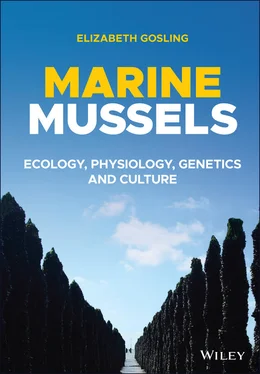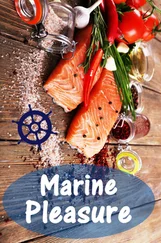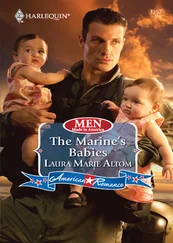72 Dame, R.F. (2012) Ecology of Marine Bivalves: An Ecosystem Approach, 2nd edn CRC Press, Boca Raton, FL.
73 Dardignac‐Corbeil, M.‐J. (1975) La culture des moules sur bouchots. Science et Pêche, 244, 1–10.
74 Dare, P.J. (1982) Notes on the swarming behaviour and population density of Asterias rubens L. (Echinodermata: Asteroidea) feeding on the mussel Mytilus edulis. Journal du Conseil, 40, 112–118.
75 Davenport, J. & Carrion‐Cotrina, M. (1981) Responses of the mussel Mytilus edulis L. to simulated subarctic tide pool conditions. Journal of Thermal Biology, 6, 257–265.
76 Davenport, J., Moore, P.G., Magill, S.H. & Fraser, L.A. (1998) Enhanced condition in dogwhelks Nucella lapillus (L.) living under mussel hummocks. Journal of Experimental Marine Biology and Ecology, 230, 225–234.
77 Davies, G.P., Dare, P.J. & Edwards, D.B. (1980) Fenced enclosures for the protection of seed mussels (Mytilus edulis L.) from predation by shore crabs (Carcinus maenas L.). Fisheries Research Technical Report, Issue 56.
78 Dayton, P.K. (1971) Competition, disturbance, and community organization: the provision and subsequent utilization of space in a rocky intertidal community. Ecological Monographs, 41, 351–389.
79 Dayton, P.K. (1973) Dispersion, dispersal, and persistence of the annual intertidal alga, Postelsia palmaeformis Ruprecht. Ecology, 54, 433–438.
80 Denny, M.W. (1995) Predicting physical disturbance: mechanistic approaches to the study of survivorship on wave‐swept shores. Ecolgical Monographs, 65, 371–418.
81 Denny, M.W. & Gaylord, B. (2010) Marine ecomechanics. Annual Review of Marine Science, 2, 89–114.
82 Denny, M.W., Miller, L.P., Stokes, M.D., Hunt, H. & Helmuth, B.S.T. (2003) Extreme water velocities: topographical amplification of wave‐induced flow in the surf zone of rocky shores. Limnology and Oceanography, 48, 1–8.
83 Diaz, R. (2013) What are dead zones? [video file]. Virginia Institute of Marine Science, October 3. Retrieved from https://www.youtube.com/watch?v=OJEWP0MlI5c.
84 Diaz, R.J. & Rosenberg, R. (2008) Spreading dead zones and consequences for marine ecosystems. Science, 321, 926–929.
85 Diaz, R., Lardies, M.A., Tapia, F.J., Tarifeño, E. & Vargas, C.A. (2018) Transgenerational effects of pCO2‐driven ocean acidification on adult mussels Mytilus chilensis modulate physiological response to multiple stressors in larvae. Frontiers in Physiology, 9, 1349.
86 Dionne, M., Lauzon‐Guay, J.‐S., Hamilton, D.J. & Barbeau, M.A. (2006) Protective socking material for cultivated mussels: a potential non‐disruptive deterrent to reduce losses to diving ducks. Aquaculure International, 14, 595–613.
87 Dolmer, P. (1998) The interactions between bed structure of Mytilus edulis L. and the predator Asterias rubens L. Journal of Experimental Marine Biology and Ecology, 228, 137–150.
88 Doney, S.C., Ruckelshaus, M., Duffy, J.E., Barry, J.P., Chan, F., English, C.A. et al. (2012) Climate change impacts on marine ecosystems. Annual Review of Marine Science, 4, 11–37.
89 Dunthorn, A (1971) The predation of cultivated mussels by eiders. Bird Study, 18, 107–112.
90 Dupont, S. & Pörtner, H.‐O. (2013) A snapshot of ocean acidification research. Marine Biology, 160, 1765–1771.
91 Durán, L. R. & Castilla. J.C. (1989) Variation and persistence of the middle rocky intertidal community of central Chile, with and without human harvesting. Marine Biology, 103, 555–562.
92 Egerrup, M. & Hoegh Laursen, M.L. (1992) Aspects of predation in intertidal blue mussels (Mytilus edulis L.) in the Danish Wadden Sea. CM/ICES K 25, l–20.
93 Elith, J. & Leathwick, J.R. (2009) Species distribution models: ecological explanation and prediction across space and time. Annual Review of Ecology, Evolution, and Systematics, 40, 677–697.
94 Erlandsson, J., Purba, P. & McQuaid, C.D. (2006) Re‐colonisation rate differs between co‐existing indigenous and invasive intertidal mussels following major disturbance. Marine Ecology Progress Series, 320, 169–176.
95 Eschweiler, N. & Christensen H.T. (2011) Trade‐off between increased survival and reduced growth for blue mussels living on Pacific oyster reefs. Journal of Experimental Marine Biology and Ecology, 403, 90–95.
96 Fabry, V.J., Seibel, B.A., Feely, R.A. & Orr, J.C. (2008) Impacts of ocean acidification on marine fauna and ecosystem processes. ICES Journal of Marine Science, 65, 414–432.
97 Faldborg, K., Jensen, K. T. & Maagaard, L. (1994), Dynamics, growth, secondary production and elimination by waterfowl of an intertidal population of Mytilus edulis L. Ophelia, Supplement6, 187–200.
98 Farrell, E.D. & Crowe, T.P. (2007) The use of byssus threads by Mytilus edulis as an active defence against Nucella lapillus. Journal of the Marine Biological Association of the UK, 87, 559–564.
99 Fauville, G., Säljö, R. & Dupont, S. (2013) Impact of ocean acidification on marine ecosystems: educational challenges and innovations. Marine Biology, 160, 1863–1874.
100 Fields, P.A., Rudomin, E.L. & Somero, G.N. (2006) Temperature sensitivities of cytosolic malate dehydrogenases from native and invasive species of marine mussels (genus Mytilus): sequence–function linkages and correlations with biogeographic distribution. Journal of Experimental Biology, 209, 656–667.
101 Fields, P.A., Cox, K.M. & Karch, K.R. (2012) Latitudinal variation in protein expression after heat stress in the salt marsh mussel Geukensia demissa. Integrative and Comparative Biology, 52, 636–647.
102 Filgueira, R., Guyondet, T., Comeau, L.A. & Tremblay, R. (2016) Bivalve aquaculture‐environment interactions in the context of climate change. Global Change Biology, 22, 3901–3913.
103 Firth, L.B., Knights, A.M. & Bell, S.S. (2011) Air temperature and winter mortality: implications for the persistence of the invasive mussel, Perna viridis in the intertidal zone of the south‐eastern United States. Journal of Experimental Marine Biology and Ecology, 400, 250–256.
104 Fitzer, S.C., Phoenix, V.R., Cusack, M. & Kamenos, N.A. (2014) Ocean acidification impacts mussel control on biomineralisation. Scientific Reports, 4, 6218.
105 Fitzer, S.C., Vittert, L., Bowman, A., Kamenos, N.A., Phoenix, V.R. & Cusack, M. (2015) Ocean acidification and temperature increase impact mussel shell shape and thickness: problematic for protection? Ecology and Evolution, 5, 4875–4884.
106 Fitzer, S.C., Chung, P., Maccherozzi, F., Dhesi, S.S., Kamenos, N.A., Phoenix, V.R. et al. (2016) Biomineral shell formation under ocean acidification: a shift from order to chaos. Scientific Reports, 6, 21076.
107 Fitzhenry, T., Halpin, P.M. & Helmuth, B. (2004) Testing the effects of wave exposure, site, and behavior on intertidal mussel body temperatures: applications and limits of temperature logger design. Marine Biology, 145, 339–349.
108 Fly, E.K. & Hilbish, T.J. (2013) Physiological energetics and biogeographic range limits of three congeneric mussel species. Oecologia, 172, 35–46.
109 Fokina, N.N., TRuokolainen, T.R. & Nemova, N.N. (2018) The effect of intertidal habitat on seasonal lipid composition changes in blue mussels, Mytilus edulis L., from the White Sea. Polar Record, 54, 133–151.
110 Frandsen, R.P. & Dolmer, P. (2002) Effects of substrate type on growth and mortality of blue mussels (Mytilus edulis) exposed to the predator Carcinus maenas. Marine Biology, 141, 253–262.
111 Franz D.R. (2001) Recruitment, survivorship, and age structure of a New York ribbed mussel population (Geukensia demissa) in relation to shore level–a nine year study. Estuaries, 24, 319–327.
112 Freeman, A.S. (2007) Specificity of induced defenses in Mytilus edulis and asymmetrical predator deterrence. Marine Ecology Progress Series, 334, 145–153.
Читать дальше












